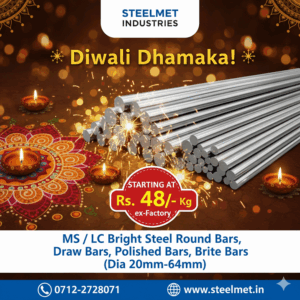At Steelmet Industries, we specialize in manufacturing precision cold drawn bright bars across multiple steel grades. One of the critical quality parameters in bright bars is straightness—a property that directly impacts machining efficiency, dimensional accuracy, and end-use performance.
However, not all steels behave the same when it comes to straightening. The ability to straighten bright bars depends heavily on the class of steel, its carbon content, alloying elements, and mechanical properties.
In this article, we compare the straightening behavior of low carbon, medium carbon, high carbon, free-cutting, alloy, and spring steels, and rank them based on ease of achieving straightness.
Why Straightness Matters in Bright Bars
Ensures consistent feed in CNC and automatic machines
Reduces tool wear and vibration
Improves surface finish in machining
Minimizes scrap and rejections
Enhances dimensional stability in components
While all cold drawn bright bars undergo a straightening process, the degree of straightness achievable varies with the steel grade.
Ranking of Steel Classes by Straightening Ability
The table below provides a comparative ranking:
| Steel Class | Straightening Ability | Rank (1 = Easiest, 6 = Hardest) | Reason |
|---|---|---|---|
| Low Carbon Steels | Very Good | 1 | Softer, lower strength, less internal stress |
| Free Cutting Steels | Good | 2 | Added sulfur/phosphorus reduces toughness, easier to bend/straighten |
| Medium Carbon Steels | Moderate | 3 | Higher hardness and strength make them less pliable |
| Alloy Steels | Moderate to Difficult | 4 | Alloying elements increase hardness, toughness, and resistance to deformation |
| High Carbon Steels | Difficult | 5 | High hardness and brittleness reduce straightening response |
| Spring Steels | Very Difficult | 6 | Designed to resist deformation, high elasticity makes straightening toughest |
Detailed Explanation by Class
1. Low Carbon Steels (Easiest to Straighten)
Examples: IS 2062, EN3B
Low carbon content makes these steels soft and ductile, so they straighten with ease and hold alignment well.
2. Free Cutting / Free Machining Steels
Examples: EN1A, EN1A(L)
Sulfur and phosphorus improve machinability but also reduce toughness. These steels straighten easily, though slight surface tearing must be considered.
3. Medium Carbon Steels
Examples: EN8, C45
Balanced hardness and strength mean moderate difficulty in straightening. Care is needed to avoid inducing surface cracks.
4. Alloy Steels
Examples: 42CrMo4, EN19
Alloy additions (Cr, Mo, Ni) increase toughness. Straightening requires precision and controlled methods, as resistance to bending is higher.
5. High Carbon Steels
Examples: EN9, C60
These steels are harder and less ductile. Straightening is challenging and carries a higher risk of cracking.
6. Spring Steels (Hardest to Straighten)
Examples: EN47, 65Si7
High elasticity is the main challenge. These steels are designed to resist permanent deformation, making straightening extremely difficult.
Conclusion
Straightness in bright bars is not just a quality metric—it directly influences efficiency and reliability in manufacturing.
At Steelmet Industries, we leverage advanced straightening equipment, process expertise, and metallurgical understanding to deliver bright bars across all steel classes—ensuring maximum straightness and consistency.
✅ Whether you need low carbon bars for machining, spring steels for critical applications, or alloy steels for high-performance components, we ensure precision straightening to meet your requirements.
📞 Call to Action
Looking for perfectly straight bright bars with tight tolerances?
👉 Connect with Steelmet Industries today for high-quality cold drawn bright bars across multiple steel grades.


